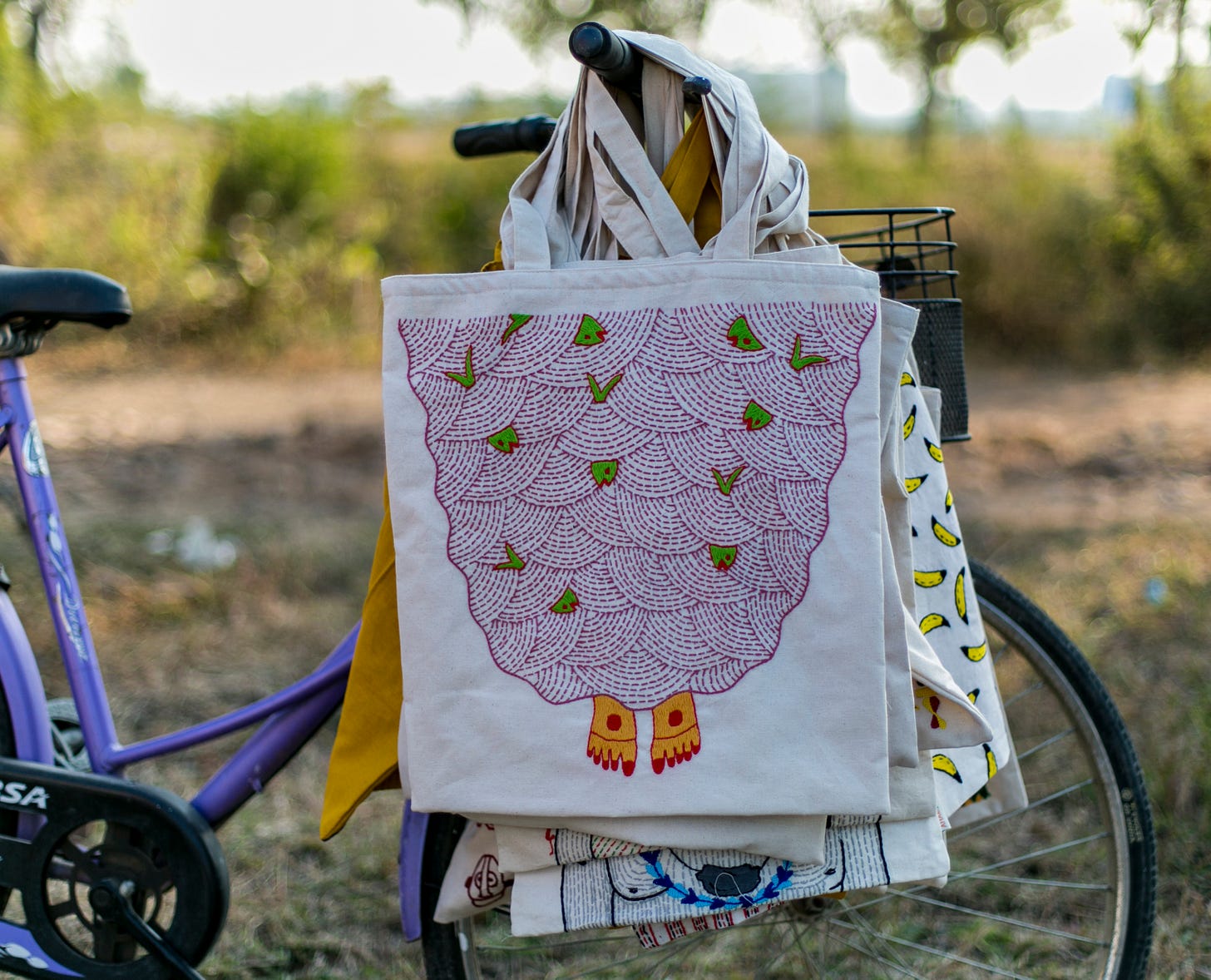This NGO is training rural women in hand embroidery!
In conversation with Aham Bhumika, a Bhopal-based NGO
Hello! 👋
Quirky tote bags and playful animals on cushion covers, anyone?
Aham Bhumika, an NGO based out of Bhopal, teaches rural women hand embroidery to provide a livelihood. They've upskilled over 60 women and produce home decor and tote bags; these products are sold on their website and social media.
I caught up with them to learn how they're helping rural women through art and education. 👇
Sunaina: Please tell me about Aham Bhumika.
Aham Bhumika: We are an NGO registered under the Societies Act and based in Bhopal. Aham Bhumika founded by a group of like-minded people who participate in social welfare activities through Aham Bhumika and work separately to support their families. The NGO works in two villages, Borda and Mahabadia, which are adjacent and located on the outskirts of Bhopal.
We have a livelihood initiative and have trained more than 60 rural women and girls in hand embroidery work in the past six years. The main aim of this initiative is to enable rural women earn a livelihood.
Women artisans make the embroidered panels and stitch them into cushion covers, tote bags and zipper pouches in a stitching unit comprising another small group of rural women. We sell these products through Facebook, Twitter, Instagram and word-of-mouth marketing.
Sunaina: What made you start Aham Bhumika, and what is its philosophy?
Aham Bhumika: We started Aham Bhumika to provide a livelihood to marginalised women who support their families. Our core aim is to ensure women can work at their doorsteps during flexible hours.
Sunaina: What goes into the production of your products?
Aham Bhumika: We’re dedicated to crafting hand-embroidered cushion covers, table runners, zipper purses, and tote bags. Our design process is a labour of love, drawing inspiration from the beauty of nature, the richness of folk art, and the depth of culture. Each idea is meticulously sketched, with every stitch and hand embroidery carefully considered for the final design. Here's a glimpse into our process 👇
We decide the stitches while the design is in progress.
Next, we make a design prototype for sampling, where the artisan creates a sample using our swatch.
Then, we review our first samples and send them for final production if they turn out well.
If they require changes, we're back to the drawing board. We go back into production only when the colours and stitches meet our design.
However, we produce in small batches, say, 5-10 pieces in one design. Sometimes, only five pieces; when we get a good response to the design, we make more pieces in a ready-to-ship condition.
Sunaina: How have you been marketing the initiative?
Aham Bhumika: Our social media presence is crucial in making us self-sustainable because a significant number of people follow our work on Facebook, Instagram, and Twitter. Whenever a new collection is out, we receive many queries from people. Besides this, we have many regular buyers who often purchase our products for gifting.
Sunaina: What's the biggest challenge you face
Aham Bhumika: The biggest challenge is selling our products. They're handcrafted and take more time and effort, so we price them accordingly, but some find them expensive. We're not a big or well-known brand and face fund constraints, so we can't spend on advertising. The lack of advertising does affect our sales.
Sunaina: What can we expect in the future?
Aham Bhumika: Our main focus currently is to engage and train more women artisans in the two villages where we work. After that, we'll train more women in the nearby villages. We also have an activity centre in the villages where we teach rural children the basics of painting and drawing. Around four years ago, one of the children who learned from our activity centre for nearly eight years got into NIFT Bhopal for a Bachelor of Design course. He successfully graduated last year.
We're grooming children interested in the arts so they can pursue a career in design; they will not only build their careers but also carry forward the initiative we've taken.
We aspire to make the village where we work a crafts village and dream of a future where designers from various parts of India stay at our activity centres to create more designs. We hope it can be a role model for the Indian design fraternity—the designers can get artisans in one place, and in turn, the artisans will also get more work, and this could be a win-win situation for both.
So, that was my conversation with Aham Bhumika. Follow them on Instagram and Twitter to discover more. Shop from their website. 👇







